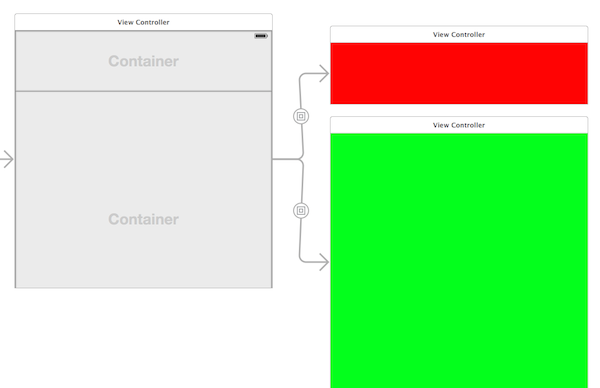Summary
Wherein I create a simple top-bottom split view, incorporating pull-to-reveal.
Intro
I needed a container view similar to a split view, but more like a pull-down to refresh. I looked at various options including MGSplitViewController.
There are 3 reasons I forewent using this library:
- The open issues hinted at iOS 8 issues.
- The project seems quite inactive
- My use-case is sufficiently narrow compared to the complexity this library offers.
So I decided to implement this myself, and it was suprisingly simple. Here are the requirements:
- Upon loading the screen should show a primary view that takes up the entire screen (on iPhone devices)
- A seconary view abutting the primary view’s top border should be revealed when a user pans down.
- If a user pans up when the secondary view is visible, that view is hidden.
- (non-functional) It should be easy to maintain each of the views via Interface Builder (IB).
Create the views
I like to start an application by creating the flow in IB. Start with an
empty view controller in IB. Create a UIScrollView which takes up the
entire screen. If using auto constraints, you can set the edges of the
scroll view to match the containing view.
Next, create two container views inside the scroll view. The secondary view should be the top-most view, with the primary view right underneath. The constraints of the primary view should be set to match the size of the scroll view (so that it takes up the entire screen). As we’re testing this, it is helpful to set the background colors of the embed views to different colors to get a visual indicator.

Setup panning
Drag a UIPanGestureRecognizer onto the View Controller, and create an
IBOutlet for it in the View Controller code. Create an IBAction with
the following signature:
CTRL+drag in IB from the UIPanGestureRecognizer to the View Controller to
hook up the IBAction. Now we’re ready for the final code changes.
Panning
We will wait until someone pans with a certain speed (you can calibrate this as desired–I started with 2000). Assuming that only the primary view is visible, if someone pans down, we want to show the secondary view, so we subtract the height of the secondary view from the scroll view’s current content offset. Otherwise, we do nothing.
If the secondary view is visible, and the user pans up, we increment the scroll view content offset by the height of the secondary view.
Finally, before the view appears, because we want to show only the primary view, we make sure that the scroll view content offset is set to the height of the secondary view to start things off.
Troubleshooting
The single most prevalent source of errors was in auto constraints, which I am still not very proficient with. I found that adding them several at a time, and evaluating the results via the simulator worked best.
Conclusion
That’s it in a nutshell. You can view the actual code used at this
repository
ios-top-down-splitview.
See both the Main.storyboard and the ViewController.m
for the actual code.